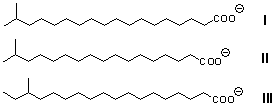
Problem Set No. 3
Lipid
Metabolism
NOTE: It is not intended that you will have to go to the original research literature to answer the questions in this problem set. Literature citations are provided in case you wish to check your answers or need assistance. If you do use the journals, please return them promptly to the stacks so that other students may use them. Unfortunately, many of these articles are no longer in the Morris Library stacks (they are in the library archives and available within 24 hours) nor are they on-line for ready access.
1. The waxes on the feathers of water birds are somewhat unusual (there are no commercial suppliers). When such birds are washed with detergents as was necessary after an oil spill on the nearby Delaware River, the natural waxes are removed along with the oil. It takes at least several days for the uropygial (preen) glands to replenish the natural waxes which are quite distinctive for each species. Hydrolysis of these waxes usually yields fatty acids containing methyl groups on even-numbered carbon atoms [Acct.Chem. Res. 4, 121 (1971)]. The dipper duck, for instance, produces two related waxes, n-hexadecyl 2,4,6-trimethyl nonanoate (76%) and n-octadecyl 2,4,6-trimethyl nonanoate (24%) [Chemica Scripta 8, 5 (1975)]. Based on analogy with the synthesis of straight chain fatty acids, predict the biosynthesis pathway of 2,4,6-trimethyl nonanoate from simple precursors? Nonanoate contains nine carbon atoms. [Biochemistry 14, 1768 & 1774 (1975)].
2. Biological membranes maintain their liquid crystalline properties over a range of environmental temperatures. At lower temperatures there is an increase in the proportion of unsaturated fatty acids which have lower melting points. Rather than produce unsaturated fatty acids to keep their membranes "flexible," Bacillus subtilus achieves the same end by producing fatty acids with a single branch methyl group [Compounds I, Eur. J. Biochem. 12, 496 (1970), II, Biochemistry 10, 340 (1971), and III, J. Biol. Chem. 246, 5264 (1971)]

What are the "initiators" for branched chain fatty acids
in B. subtilus? (Acetyl CoA is the initiator of straight chain fatty
acids). What common compounds give rise to these unusual initiators?
3. An in vitro system containing mitochondria and soluble
cytoplasmic enzymes is capable of synthesizing fatty acids from 2-l4C-pyruvate. Fatty acid synthesis
in this system can also be measured by the incorporation of 3H from 3H2O. It was observed
that when unlabeled citrate was added to the system, the amount of 14C-labeled fatty acid formed decreased
while the amount of 3H-fatty acid formed increased under the same conditions. Explain.
[J.
Biol. Chem 245, 5993 (1970)]. Fatty acid synthetase is a cytoplasmic
enzyme. Where does 3H get incorporated into fatty acids?
4. Bacteria such as E coli synthesize monounsaturated fatty acids via an anaerobic pathway while animals and yeast synthesize monounsaturated fatty acids via an aerobic pathway. Below are several unsaturated fatty acids isolated from E. coli and mammalian liver. What can be concluded about the formation of the double bond in the two different pathways from structures given?
5. Beta-oxidation of saturated fatty acids is an essential catabolic pathway in man. There are in addition several enzymes which permit the oxidation of D9,10 cis unsaturated fatty acids and branched chain fattyacids. Phytanic acid (derived from the phytol side chain of chlorophyll) cannot be metabolized in people with Refsum's disease [J. Inherit. Metab. Dis. 21, 697 (1998)]. It creates another degradative problem. It is thought that these people lack the capacity for a-oxidation. Why can't phytanic acid be degraded entirely by beta-oxidation? Propose a pathway for the degradation of phytanic acids in normal humans. Phytanic acid belongs to what class of compounds? (It is a fatty acid, but that is not a class that would be informative given its structure below.)
This assignment has several purposes:
1. To give you practice seeing patterns in structures
that relate to the modular assembly of fatty acids.
2. To provide examples of the importance of lipid
in different biological contexts.
3. To provide you with access to the primary
literature on lipid metabolism.
This assignment will be evaluated on the following elements:
1. Clear and logical explanations.
2. Appropriate use of chemical structures to illustrate
important points.
3. Turned in on time.